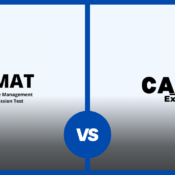
How Hard Is the GMAT?
The Graduate Management Admissions Test (GMAT) is an essential step for candidates aspiring to gain entry into the competitive landscape of business schools worldwide. Administered by the Graduate Management Admission Council (GMAC), the GMAT opens doors to over 7700 programs across more than 2400 business schools globally. This standardized test is highly regarded by prestigious institutions like Wharton, Harvard Business School, INSEAD, and others, making it a significant milestone for prospective MBA students.
The sheer scale of the GMAT is reflected in the numbers, with more than 2 lakh tests taken last year alone, underscoring its status as one of the most competitive exams for MBA program admissions. What sets the GMAT apart is its flexibility, allowing candidates to register for the exam and select their preferred day and time, catering to individual schedules and convenience. Upon completion of the exam, candidates receive real-time scores, with official scorecards typically available within approximately 20 days.
Recent developments have introduced the GMAT Focus edition, launched on November 23 last year, which will officially transition to being known as the GMAT exam post July 2024. It’s imperative for candidates to stay updated with the latest information through official platforms like mba.com or gmac.com, as the exam may undergo pattern changes or introduce new sections over time. Seeking guidance and mentorship from experienced MBA Admission professionals can also be instrumental in navigating the preparation process effectively.
The GMAT is designed to assess candidates on a wide range of skills essential for future business leaders, providing valuable insights into the expectations of MBA programs. The scoring range of the exam (205 to 805) signifies its rigor, with only about 6% of test takers achieving scores of 665 or higher, highlighting its demanding nature.
Preparing for the GMAT presents multifaceted challenges, requiring candidates to delve into exam patterns, master specialized areas, and develop strategies that align with their busy lifestyles. Juggling commitments such as jobs or college adds an extra layer of complexity to the preparation journey.
Furthermore, the exam’s adaptive format adds another dimension of challenge. The Computer Adaptive Test (CAT) adjusts question difficulty levels based on previous responses, providing a tailored testing experience for each candidate. The GMAT Focus edition allows candidates to revisit and change responses to three questions per session, adding to the complexity of time management during the exam.
Navigating these challenges requires a comprehensive understanding of concepts, including formulae and grammar rules, coupled with effective application skills. It’s not just about knowing the material; it’s about applying that knowledge efficiently under pressure.
While high GMAT scores are important, they are just one aspect of securing admission to prestigious business schools. Admissions committees evaluate candidates holistically, considering various aspects of their profile. Professional assistance, coupled with a clear strategy and access to quality resources, can significantly enhance a candidate’s overall profile and increase their chances of securing a coveted spot in their dream school.In conclusion, cracking the GMAT requires dedication, strategic preparation, and the right support system. It’s not just a test; it’s a gateway to a world of opportunities in the dynamic field of business education.



